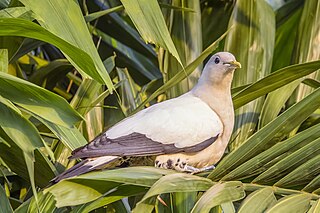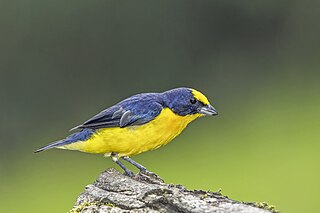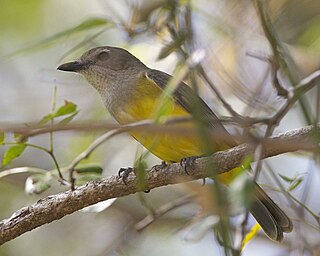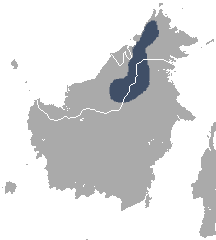
A woodworm is the wood-eating larva of many species of beetle. It is also a generic description given to the infestation of a wooden item by these larvae.

The pied imperial pigeon is a relatively large, pied species of pigeon. It is found in forest, woodland, mangrove, plantations and scrub in Southeast Asia, ranging from Myanmar and Thailand, throughout Indonesia and east to the Philippines and the Bird's Head Peninsula in New Guinea. It is mainly found on small islands and in coastal regions. It remains locally common, and is therefore considered to be of least concern by BirdLife International and IUCN.

The New Zealand bellbird, also known by its Māori names korimako, makomako, and kōmako, is a passerine bird endemic to New Zealand. It has greenish colouration and is the only living member of the genus Anthornis. The bellbird forms a significant component of the famed New Zealand dawn chorus of bird song that was much noted by early European settlers. The explorer Captain Cook wrote of its song "it seemed to be like small bells most exquisitely tuned". The species is common across much of New Zealand and its offshore islands as well as the Auckland Islands.

The blackstart is a chat found in desert regions in North Africa, the Middle East and the Arabian Peninsula. It is resident throughout its range.

The black-tailed gnatcatcher is a small, insectivorous bird which ranges throughout the Sonoran and Chihuahuan Deserts of the southwestern United States and northern Mexico. It is nonmigratory and found in arid desert areas year-round.

Laudakia melanura, also known as the black agama or black rock agama, is a species of agamid lizard. It is found in Iran, Afghanistan, Pakistan, and northern India.

Arachnura, also known as drag-tailed spider, scorpion-tailed spider and scorpion spider, is a genus of orb-weaver spiders that was first described by A. Vinson in 1863. They are distributed across Australasia, Southern and Eastern Asia with one species from Africa. Females can grow up to 1 to 3 centimetres long, while males reach only 2 millimetres (0.079 in) long. The name is a combination of the Ancient Greek "arachne-" (ἀράχνη) and "uro" (οὐρά), meaning "tail". The tails are only present on females, but unlike the common names suggests, these spiders aren't related to scorpions. They curl up their tails when disturbed, but they are completely harmless. Bites are rare, and result in minor symptoms such as local pain and swelling. They stay at the middle of their web day and night, and their bodies mimic plant litter, such as fallen flowers, twigs, or dead leaves.

The Torresian imperial pigeon, also known as the nutmeg pigeon, white nutmeg pigeon, Australian pied imperial pigeon or Torres Strait pigeon, is a relatively large, pied species of pigeon. It is found in forest, woodland, savanna, mangrove and scrub in Australia, New Guinea, Aru Islands, islands in the Geelvink Bay, D'Entrecasteaux Islands and Louisiade Archipelago.

The thick-billed euphonia is a species of bird in the family Fringillidae, formerly placed in the Thraupidae.

The mangrove golden whistler or black-tailed whistler, is a species of bird in the family Pachycephalidae. It is found in mangrove forests and adjacent wet forests of Papua New Guinea and Australia.

The Bornean smooth-tailed treeshrew is a species of treeshrew in the family Tupaiidae. It is endemic to Borneo. Its natural habitat is subtropical or tropical dry forests. It is threatened by habitat loss.

Craspedosis is a genus of moths in the family Geometridae.
Scotiomyia is a genus of flies in the family Dolichopodidae. It is distributed in Papua New Guinea, Singapore and China.

Dichagyris melanura is a moth of the family Noctuidae. It is found from south-eastern Europe to Turkey, the Caucasus region, north Iran, Israel, Syria and Jordan.

Stenurella melanura is a flower longhorn beetle species of the family Cerambycidae, subfamily Lepturinae.
In ethology, the nasty neighbour effect describes the phenomenon whereby territory-holding animals behave more strongly toward familiar conspecific neighbours than to unfamiliar conspecifics. This phenomenon may be generally advantageous to an animal because the heightened response reduces the likelihood of a nearby intruder entering the territory and taking the resources it contains whereas an unfamiliar or distant territory-holder poses less of a threat. This reduced response minimises the time, energy, and risk of injury incurred during territorial encounters with animals which are less of a threat to the territory holder. The nasty neighbour effect is the converse of the dear enemy effect in which some species are less aggressive toward their neighbours than toward unfamiliar strangers.

Pterolophia melanura is a species of beetle in the family Cerambycidae. It was described by Francis Polkinghorne Pascoe in 1857. It has a wide distribution in Asia.
Culiseta melanura, the black-tailed mosquito, is a species of mosquito in the family Culicidae. Adult female C. melanura primarily take their blood meals from birds and are responsible for transmitting the eastern equine encephalitis virus between birds. Mammals can also become infected with the virus when other genera of mosquito, such as Aedes, Coquillettidia, and Culex, take blood meals first from infected birds and then from mammals, causing transfer of the virus.
Melitta melanura is a species of Melitta.















